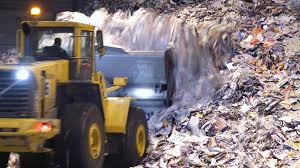 Around we go – the shape of future waste management is circular
Around we go – the shape of future waste management is circular
As we move toward a waste-free future, the challenges of waste management can only be solved by open, cross-industrial partner networks. UPM will end the disposal of waste at landfills in Finland within a couple of years. The same target will apply globally by 2030. To reach this target, UPM works together with its waste management partners to promote the circular flow of side streams.
UPM’s Zero Solid Waste to Landfill project aims to find sustainable end uses for five different production side streams: ash, sludge, green liquor dregs, bark sand, and mixed waste. In the challenging task of utilizing these side streams more efficiently, UPM’s waste management partners play an important role, starting with the meticulous sorting and monitoring that this requires.
In Finland, UPM’s day-to-day waste management is handled by two companies: Lassila & Tikanoja, and Fortum. Lassila & Tikanoja provide a variety of services, including waste management, property maintenance, cleaning, environmental construction and process cleaning. They also supply UPM with recyclable raw materials in the form of waste paper collected from households and businesses. Fortum meanwhile handles UPM’s hazardous waste collection and treatment throughout Finland.
“The current trend is clear: resource and material efficiency are becoming increasingly important in industry. Both industrial companies and their service providers need to respond to this trend,” says Antti Tervo, Vice President, Industrial Services at Lassila & Tikanoja.
“The sourcing of industrial waste management services is becoming more and more professional, with companies seeking innovation and better practices during each round of negotiations. The forest industry has long stood out as an excellent recycler. The industry is exceptionally knowledgeable about managing material streams, as integrated mill sites have been recycling side streams internally for decades,” says Tero Svinhufvud, Vice President of Sales at Fortum.
Balancing technology, finances and regulations
Solutions already exist for the reuse of most industrial side streams. The challenge lies in balancing regulations against financial considerations, technology and practices.
“The recycling requirements of industrial companies are constantly being influenced by the consumer market. The goal of the circular economy and the biological and technical material cycle is for waste to be reused as raw material as close to its source as possible. However, this will not take place overnight. The change will require solutions that take into account both financial imperatives and technical solutions,” says Tervo.
“Apart from badly contaminated soil, all materials can already be recycled, but often the costs are too high to make the process viable. It is essential that industry and other operators work in close collaboration to find solutions. Together we can influence decisionmakers so that external regulations and steering do not limit the utilization of side streams without justified grounds,” he adds.
External regulations are among the biggest challenges for industrial companies. Regulations often vary regionally for different waste fractions, which makes decision-making more difficult.
Financial challenges are the most straightforward to tackle for most companies. However, if a wholly new infrastructure or service model is required, the relevant regulations need to be in place for companies to pass decisions concerning capital expenditure or investment in new technology.
“We already have a good understanding of technical solutions and why materials behave as they do. We are aware of the impurities that may prevent them from being reused. In most cases, however, the technologies and procedures used for removing impurities are expensive, but sometimes the reduced environmental impacts are so great that changes are made despite the high costs. Often a change becomes profitable after regulations are amended,” notes Svinhufvud.
But he adds: “Unfortunately, opportunities for reusing side streams are often missed because of the slow permit process.”
Open value networks
Both Fortum and Lassila & Tikanoja are aware of the importance of new value networks in the future of waste management.
“The sharing of resources will provide companies with a competitive edge. In a small country like Finland, and in Europe overall, different industries should be bold and open in their collaboration with others,” Tervo says.
“New solutions will not come out of thin air in this industry. It will become increasingly important to know exactly what materials each side stream or type of waste contains. Innovations will probably be related to new combinations of material streams and the more efficient use of streams in specific applications. Digitalization will facilitate this work, but it is not the magic answer to every challenge,” Svinhufvud adds.
